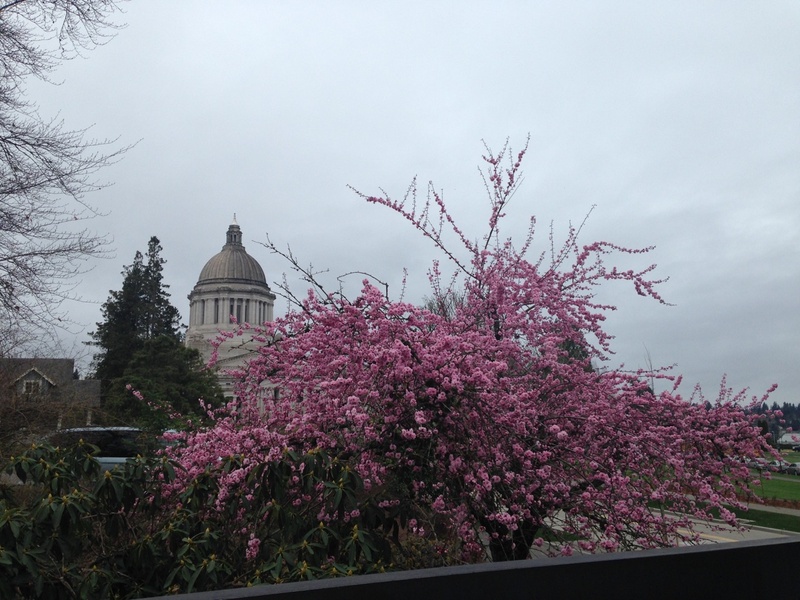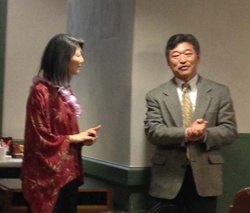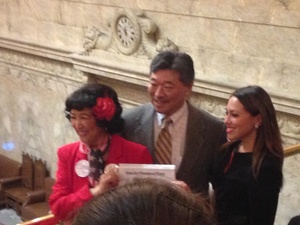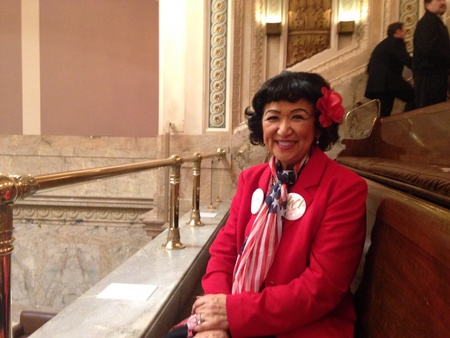This year’s Day of Remembrance began early for me, and—of all places—on social media. I read Densho’s request to change my Facebook profile picture to Frank Fujii’s logo “Ichi-Ni-San,” which was used for the 1978 Day of Remembrance in Seattle 1978, and changed mine on February 15th. It was heartening to see the profile pictures of a few other Japanese Americans that I know on social media; it was a gift of solidarity.
However, I also changed my cover photo—the larger image displayed prominently on my Wall—to a photo I’d taken last year. The photo was a replica of the camp register at Tule Lake, with the names of my grandfather, grandmother, father, and aunts and uncle listed, as well as their block number and barracks number. I took the picture when I visited the Tule Lake Fairgrounds museum at last year’s Tule Lake pilgrimage. The register is at the front desk and although I knew it was a replica, it was still something to see my family’s names, to touch their history just a few miles from where they lived for a few years behind barbed wire.
Many people who know me are aware of my connection to camp history; my dad and his family were incarcerated at Tule Lake. Still, I was surprised by my friends’ reaction to the register photo. People responded with expressions of awe (‘wow” or “amazing” or “chills”). Seeing my last name on the register, combined with those of my family members, brought the day home in ways that links to articles or videos could not.
I wanted to bring the day home to people, but I also wanted to bring it further, so on February 19, I traveled to Olympia. The first thing I noticed were the cherry blossoms, blooming already near the Washington State Capitol.
Although it was February, the Pacific Northwest was experiencing an early spring after a mild winter. After reading an announcement by Densho, I decided to attend a Day of Remembrance in Olympia, the capital of Washington. I’d attended other Days of Remembrance, mostly in the Bay Area of California, so I was eager to see this one for the first time. In Washington there seem to be two larger community events, one earlier in February as a taiko performance fundraiser for the Minidoka Committee. The second is a day of action at the legislature. We had been invited by our Nikkei representatives, State Representative Sharon Tomiko Santos and State Senator Bob Hasegawa to observe the Day of Remembrance.
Although I’ve lived in Washington for almost twenty years, I’d never seen the Capitol building before and it was beautiful—filled with filigree ceilings and marble staircases. The center of the building was all balconies and stairways under the capitol dome, which seemed to represent the importance of travel and meeting.
The South House Gallery was full, and it was moving to see rows and rows of so many Nikkei faces at the Legislature. An Asian American Boy Scout troop from Seattle was waiting on the floor below us, waiting to present the colors when the session was convened. Senator Bob Hasegawa and his daughter Toshiko were in the gallery with us, and Representative Santos was on the floor. Toshiko is currently a development manager for the National JACL, and organized this year’s event. The two posed for photos with Puyallup JACL president, Elsie Taniguchi, who I’d met at a meeting of the Camp Harmony Committee in January. School groups came in and watched quietly, sitting in the galleries across from us.
After some waiting, the Speaker banged the gavel to convene the session. Reverend Ken Miyake of Seattle offered an opening prayer before the reading of the resolution. His daughter, Rep. Santos, rose to present Senate Resolution 8617, to acknowledge the 73rd anniversary of the signing of Executive Order 9066. Although the resolution has been first offered in past years in the House, this year Senator Hasegawa presented it first in the Senate. Rep. Santos spoke about the importance of the resolution, even at one of the busiest times of the legislative session.
Though I did not recognize many community members at first, I felt a special kinship with Rep. Santos as she spoke about the values that had sustained and nourished the Japanese American community over the years. By the time she arrived at the final value, kodomo no tame ni (for the sake of the children) I felt that I knew what she was going to say. That shared recognition along with the deep emotion in her voice brought some tears for me, and for others sitting in the gallery and on the House floor. There is a lot that I have to learn about Nikkei history in my adopted home state, but there are also shared values that cross state and chronological borders. It’s these values, as much as anything else, that make a community.
Later, over bento and sushi lunches in a different room, I realized that there were close to two hundred people present. I kept running into more people that I recognized from different events. Recognizing a familiar face from Tacoma, I introduced myself to Karen Yoshitomi, executive director of the Japanese Cultural and Community Center of Washington. An organizer of past DOR, she’s proud of the direct access that the Nikkei community has to our legislators in Olympia. I see members of the Camp Harmony Committee, who I met in January, from Fife and Puyallup, just next to Tacoma.
After the lunch line I find a spot next to a kindly woman, who introduces herself as Arlene Oki. We play the “how many degrees of JA separation” game, and it’s over very quickly—I tell her that I write for Discover Nikkei/JANM, but that I also write for the International Examiner, a Seattle Asian American community newspaper. “Oh! That’s my paper!” she exclaims; she’s on the board. I ask her how long she’s been coming to the Olympia DOR, and she looks up for a few seconds, thinking back. “Oh, as long as it’s been going on, almost fifteen, twenty years now. Since Kip Tokuda.” Tokuda, a prominent community leader, was also a State Representative, and passed away unexpectedly in 2013. In later e-mail correspondence with me, Toshiko Hasegawa elaborated on the day’s history: “[Tokuda] knew the value of this lesson in history, and the importance of these lessons to be observed by our lawmakers, each year.”
“That’s why we’re here,” Arlene says. “ To ask for funding for the [Washington State] Civil Liberties Public Education Fund.” Although California’s public education fund ceased in 2011, I was a little surprised. “Washington State doesn’t have a fund?” It was explained to me that the bill was passed in 2000, signed by then-Washington governor Gary Locke, to develop a grant program. The state did have a fund and a program for 9 years, but funding was cut in 2009. In 2015, Governor Jay Inslee included $250,000 in the state budget for the fund. Members of the community, including area JACL chapters and the Nisei Veterans Committee, were asked to come to this year’s DOR in order to meet with legislators about funding for the program. The fund is now named the Kip Tokuda Memorial Washington Civil Liberties Public Education Fund.
I left Olympia and the Capitol feeling inspired to take action, and to write. But I also felt the presence of community, the welcome feeling of being in the same room of Nisei, Sansei, and Yonsei sharing stories. Toshiko Hasegawa eloquently expressed the feeling of many Sansei and Yonsei, in the importance of honoring our elders:
In Japanese culture…. we are nothing more than a product of what other people have done for us. We are who we are because of what so many others who came before us have done. I am who I am, because of you. ‘Okage sama de’: ‘I stand in the honor of your shadow’. I carry this notion in my heart and inked on my wrist, so that when people ask me about it, they too can appreciate the notion….One day a year towards honoring the legacy of our precious Nisei is absolutely something I am compelled to do.
Like Toshiko, I could feel the presence of that past; I knew that I was sitting there because my family and my elders and my wider community had made it possible for me to enter those halls, and even to claim a place where the history and members of my community were being honored.
Just after the resolution reading, I managed to catch a short conversation with Nisei elder Elsie Taniguchi. “Yes, it’s good that you were here today,” she said, holding my hand lovingly. “It’s one thing to hear about it. But it’s another thing to be here, to feel the kimochi—that’s really special.”
© 2015 Tamiko Nimura










